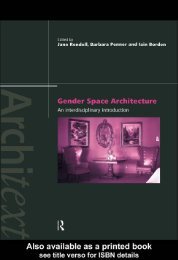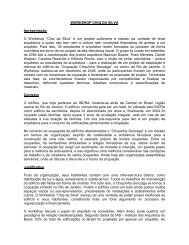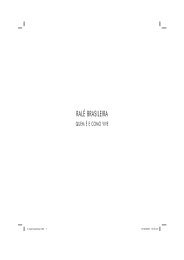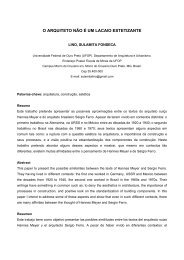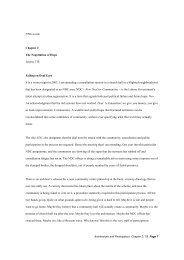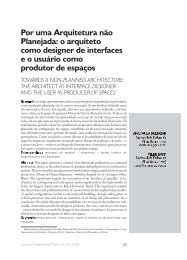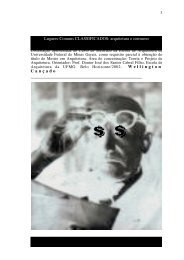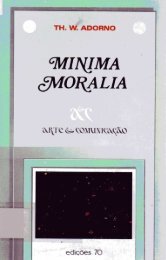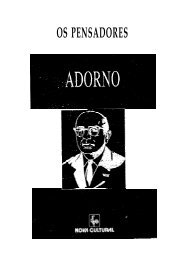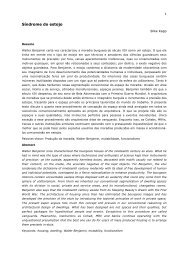Architecture and Modernity : A Critique
Architecture and Modernity : A Critique
Architecture and Modernity : A Critique
You also want an ePaper? Increase the reach of your titles
YUMPU automatically turns print PDFs into web optimized ePapers that Google loves.
chaos. Tafuri argues, however, that the tendency toward irony that was an aspect of<br />
this movement meant that a need for order was felt here too. “Dada instead plunged<br />
into chaos. By representing chaos, it confirmed its reality; by treating it with irony, it<br />
exposed a necessity that had been lacking.” 154 Tafuri points, therefore, to an inner relationship<br />
between the constructive <strong>and</strong> destructive moments within the avantgarde.<br />
For this reason, he argues, it was no surprise that dadaism <strong>and</strong> constructivism<br />
merged after 1922. 155<br />
According to Tafuri, then, the whole concern of the avant-garde movements<br />
was to recognize <strong>and</strong> assimilate the dialectic of chaos <strong>and</strong> order that is fundamental<br />
to modern mechanized civilization: the dialectic between the apparent chaos of the<br />
constantly changing dynamic image of the city on the one h<strong>and</strong> <strong>and</strong> the underlying<br />
order of the de facto rationality of the system of production on the other—a rationality<br />
that in every case was deemed to be the decisive factor. The artistic labor of<br />
the avant-garde movements involved an assimilation of the new conditions of life<br />
that prevail in the modern city. This process of assimilation was a necessary precondition<br />
for a more thoroughgoing interiorization of these conditions by the people who<br />
were subjected to them. In Tafuri’s scheme of things, the avant-garde movements<br />
are assigned the task of paving the way for a further proliferation <strong>and</strong> evolution of<br />
mechanistic civilization. They are, however, incapable of extending their assignment<br />
any further than this “vanguard” task: “The necessity of a programmed control of the<br />
new forces released by technology was very clearly pointed out by the avant-garde<br />
movements, who immediately afterwards discovered that they were not capable of<br />
giving concrete form to this entreaty of Reason.” 156<br />
The avant-garde movements were incapable of genuinely influencing the<br />
course of capitalist evolution or of giving concrete form to the rationalization inherent<br />
in it. This task, Tafuri argues, was the work of architecture: “The Bauhaus, as the decantation<br />
chamber of the avant-garde, fulfilled the historic task of selecting from all<br />
the contributions of the avant-garde by testing them in terms of the needs of productive<br />
reality.” 157 <strong>Architecture</strong> should be the mediator between the “progressive”<br />
dem<strong>and</strong>s in the work of avant-garde movements (including the dem<strong>and</strong> for the<br />
planned control of the means of production) <strong>and</strong> the concrete reality of this production.<br />
According to Tafuri’s diagnosis, however, architecture gets bogged down in this<br />
contradiction, because it is not prepared to accept its logical implication—that the<br />
contradiction can be solved only by a form of planning instituted outside of architecture,<br />
that would involve “a restructuring of production <strong>and</strong> consumption in general;<br />
in other words, the planned coordination of production.” 158<br />
The fully planned control of production can be implemented only when there<br />
is a general socioeconomic form of planning that embraces all the sectors of social<br />
life <strong>and</strong> that is not confined to architecture. For architects to accept the consequences<br />
of this would mean disqualifying themselves: architecture would no longer<br />
be the subject of the plan but its object—<strong>and</strong> that is something that architects could<br />
not possibly accept: “<strong>Architecture</strong> between 1920 <strong>and</strong> 1930 was not ready to accept<br />
3 Reflections in a Mirror



